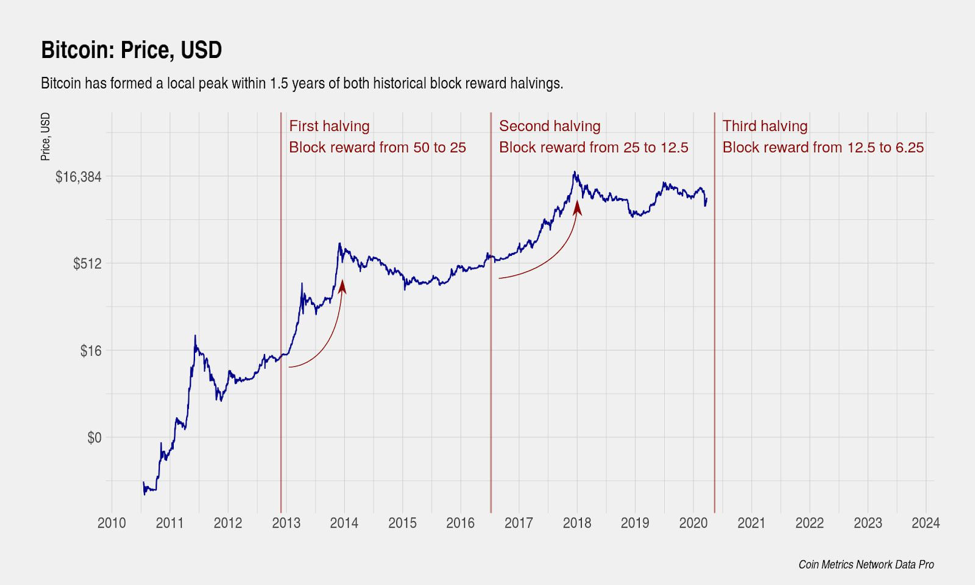Table of Contents
You may have heard of something called a Bitcoin ‘halving’ occurring this year. In May 2020, Bitcoin went through its third halving, and its reward value dropped from 12.5 to 6.25 BTC per block mined. This essentially means that the reward for mining a block was cut in half yet again.
But how does this work?
In a centralized economy, the central bank is responsible for controlling the supply of money. However, in the case of cryptocurrencies like Bitcoin, there is no such centralized authority to control its monetary base. This necessitates that Bitcoin as a cryptocurrency must have its own mechanism to ensure a controlled supply.
This is where the concept of Bitcoin halving (or ‘halvening’) comes in. After every 210,000 blocks that are mined, the reward awarded to miners for every block gets halved. As a result, new bitcoins are released into circulation at only half the rate as compared to before that. (This is distinct from a coin burn – a mechanism that other cryptocurrencies apply to manage inflation)
Therefore, this controlled release of bitcoins helps maintain a synthetic form of Bitcoin inflation. This halving would continue till all the bitcoins have entered circulation, and after that, miners would be rewarded with the fee that network users will pay for processing transactions.
Get WazirX News First
Why is Bitcoin Halving Important for Cryptocurrency Investors?
Is there any significance of this phenomenon for cryptocurrency investors? This is easier to understand when we notice the patterns that are set off by a halving event. When a halving occurs, bitcoins’ supply decreases, and the consequent higher demand leads to a rise in Bitcoin prices. And quite clearly, Bitcoin halvings in the past have resulted in a dramatic rise in Bitcoin prices, only to drop later. Let’s have a look.
- The First Halving
In November 2012, the first Bitcoin halving took place, halving the reward for mining from 50 to 25 BTC. The consequent effect on the prices saw a surge of about 8000% in the year that followed.
- The Second Halving
The second such event occurred in July 2016 when the reward was halved from 25 to 12.5 BTC, and as a result, Bitcoin prices surged by nearly 1000%.
- The Third Halving
The events of May 2020 have again led to an all-time high in Bitcoin prices, nearly reaching $20,000 in November 2020.

Therefore, crypto investors can make use of this knowledge in various ways. Understanding the market fluctuations – price rise followed by a drop – is important for anyone who intends to make gains from these market movements. At the same time, it is also important to understand the effects of other global situations, such as the ongoing pandemic, to figure out whether all halvings will necessarily result in similar price movements.
For bitcoin miners, understanding the halving of the mining reward with respect to increasing value is essential. For example, if the third halving was expected to reduce the Bitcoin inflation rate from 3.6% to 1.8%, then these changes are relevant to how the gains would be calculated. The operational costs of mining, such as hardware, electricity, etc., are estimated at $6,851 by Bitcoin.com. This corresponds to a 30% margin because 70% of the block rewards would have to be sold to cover the operational costs. So if the halvings push up the Bitcoin price but not by much, then it is not a great investment for miners (while being great for investors).
For new investors, Bitcoin halving presents a great opportunity to understand the cryptocurrency domain and begin making investments.
Conclusion
Crypto investors, particularly those holding Bitcoins for sufficient duration to make gains, can benefit greatly from such halvings. For a volatile asset, such a pattern that has occurred thrice so far seems fairly consistent.
With the next halving expected in another 4 years, it remains to be seen whether the price-boost pattern is set in stone or simply happens to coincide with other market forces.
Also you can download the app and Start Trading Now!
Android App – Bitcoin Exchange
iOS App – Cryptocurrency Exchange
Frequently Asked Questions
Is Cryptocurrency Safe To Invest In?
Cryptocurrency investments are subject to market risks, but if sufficient security measures are not taken, trading accounts can be maliciously accessed. Investments come with risks and uncertainties, and we cannot claim that any digital currency investment is risk-free. Buying and selling cryptocurrencies can be risky even if the trader is knowledgeable about the market and treats their coins carefully.
What Is The Meaning Of Bitcoin?
Bitcoin is a type of cryptocurrency that was first introduced in January 2009. It is invented based on the key concepts and notions presented in a whitepaper by Satoshi Nakamoto, a mysterious and pseudonymous figure. The name of the individual or people who invented technology is yet unknown. Bitcoin promises reduced transaction fees than existing online payment methods, and a decentralized authority controls it, unlike government-issued currencies.
How To Invest In Cryptocurrency Stocks?
Cryptocurrency can be purchased in two ways: through mining or exchanges. The process of confirming and adding transactions to the blockchain public ledger is known as cryptocurrency mining. Cryptocurrency exchanges are another option. Exchanges make money by charging transaction fees, but there are alternative platforms where you may communicate directly with other cryptocurrency traders.
What Are The Best Cryptocurrencies To Invest In?
The best cryptocurrencies to invest in would be the ones you study and analyze in detail. Some of the most popular cryptocurrencies include Bitcoin, Ethereum, and many altcoins such as Tron, Ripple, Litecoin, etc.
How To Invest In Cryptocurrency?
There are two ways of investing in cryptocurrency, mining and via exchanges. Cryptocurrency mining is considered the procedure of verifying and adding transactions to the blockchain public ledger. Another option is via cryptocurrency exchanges. Exchanges generate money by collecting transaction fees, but there are alternative websites where you can interact directly with other users who want to trade cryptocurrencies.
Are Cryptocurrencies A Good Investment?
Cryptocurrency has the potential to make you extremely wealthy, and the potential to cause you to lose your money. Crypto assets, like any other investment, come with many risks and potential rewards. Fundamentally, cryptocurrency is an excellent investment, particularly if you want to gain direct exposure to the demand for digital currency.
Is Bitcoin Cash A Good Investment?
Bitcoin Cash is a hard fork of Bitcoin formed in 2017 to address Bitcoin's scalability and challenges. Bitcoin Cash seeks to make global transactions faster, cheaper, and more secure. Bitcoin Cash is now accepted by thousands of online and offline businesses all over the world. Studied correctly, Bitcoin Cash may be an investment worthy of consideration.
Who Created Bitcoin?
Bitcoin is the first application of the concept of "cryptocurrency," first articulated in 1998 on the cypherpunks mailing list by Wei Dai, who proposed a new form of money that relies on cryptography rather than a central authority to manage its creation and transactions. Satoshi Nakamoto published the initial Bitcoin specification and proof of concept on the cryptography mailing list in 2009. Satoshi exited the project in late 2010, with little information about himself available. Since then, the community has evolved, with numerous people working on Bitcoin. Satoshi's anonymity has sparked unfounded fears, many of which may be traced back to a misunderstanding of Bitcoin's open-source nature.
How To Make Bitcoin?
Bitcoin mining is not just the process of putting new Bitcoins into circulation, but it is also an essential part of the blockchain ledger's upkeep and development. It is carried out with the assistance of highly advanced computers that answer challenging computational math problems. Miners are rewarded for their efforts as auditors. They are in charge of ensuring that Bitcoin transactions are legitimate. Satoshi Nakamoto, who is the founder of Bitcoin, innovated this standard for keeping Bitcoin users ethical. Miners help to prevent the "double-spending problem" by confirming transactions.
Is Bitcoin And Cryptocurrency The Same Thing?
Bitcoin is a cryptocurrency that was designed to facilitate cross-border transactions, eliminate government control over transactions, and streamline the entire process without third-party intermediaries. The absence of intermediaries has resulted in a significant reduction in transaction costs. Satoshi Nakamoto, the creator of Bitcoin, created the first cryptocurrency in 2008. It began as open-source software for money transfers. Since then, plenty of cryptocurrencies have emerged, with some focusing on specific fields.
 Disclaimer: Click Here to read the Disclaimer.
Disclaimer: Click Here to read the Disclaimer.





















